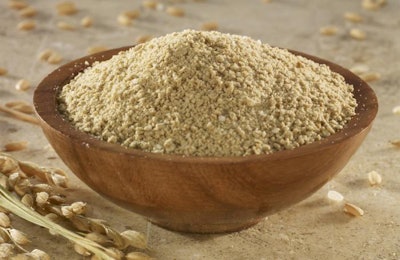
The same pet food customers who look for functional ingredients also may factor environmental sustainability into their buying decisions. Adding stabilized rice bran to dog food recipes allows manufacturers to promote their products as healthy for both dogs and the planet, according to Darrell Ward, vice president of animal nutrition sales at RiceBran Technologies.
“In wet or semi-moist diets, you can replace up to two or three percent of the meat with stabilized rice bran, and it will increase your yields,” said Ward. “Typically, you’ll see a cost savings.”
Stabilized rice bran can serve as a functional ingredient in pet foods by providing nutrients while replacing a percentage of meat. The bran also absorbs moisture, which can give products a thicker consistency.
However, most of the world’s rice bran goes to waste because of consumer demand for white rice along with a specific chemical characteristic of the rice bran.
Stabilization can make rice bran a superfood
The bran, or outer casing, of the rice grain contains antioxidants, tocopherol, B vitamins and other components that should allow rice bran to fit into the popular category of superfoods, said Ward. However, for much of the world’s rice supply, the bran is shaved off to produce white rice.
The bran contains 18 percent to 20 percent fat, along with the enzyme lipase. The enzyme causes the fat in the rice bran to go rancid and unpalatable quickly.
Rice bran rescued from the trash
That results in 60 to 70 million tons of bran being wasted or sold for low prices, according to Robert Smith, PhD, CEO of RiceBran Technologies. Making use of that wasted resource gives stabilized rice bran credentials as an ecologically sustainable pet food ingredient.
Smith’s company specializes in using extrusion to deactivate the enzyme lipase and make rice bran a useable ingredient for both humans and animals. No other chemicals are added during the process. The heat produced by friction in the extruder neutralizes the enzyme.
Previously, the main method for keeping rice bran from going bad was to extract the fat from it using hexane. However, some pet food consumers balked at products that used a petrochemical in the production process of de-fatted rice bran, said Smith.
Cost savings
RiceBran Technologies calculated the hypothetical cost savings from replacing two percent of the meat in a recipe for a dog treat stick with one of their stabilized rice bran products, NutraCea. Use of the product resulted in an improved cook/dried yield of 0.6 percent, and a 2.76 percent cost savings compared to the conventional product formulation, according to the company’s figures.
Rice bran at Petfood Innovation Workshop
Rice Bran Technologies demonstrated how to make a meat snack for dogs that incorporates stabilized rice bran, at the Petfood Innovation Workshop and Kansas State University (KSU) Pet Food Experience September 13-15.
Upcoming Petfood Innovation Workshop
Petfood Innovation Workshop will kick off Petfood Forum’s conference and exhibition on April 3, 2017.


















